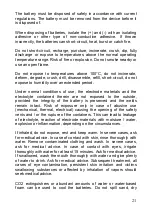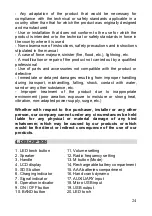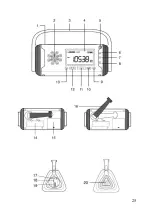
21
The battery must be disposed of safely in accordance with current
regulations. The battery must be removed from the device before it
is disposed of.
When disposing of batteries, isolate the (+) and (-) with an isolating
adhesive or other type of non-conductive adhesive. If thrown
incorrectly, the batteries can short-circuit, heat, burst or catch fire.
Do not short-circuit, recharge, puncture, incinerate, crush, dip, fully
discharge or expose to temperatures above the normal operating
temperature range. Risk of fire or explosion. Do not smoke nearby or
use an open flame.
Do not expose to temperatures above 100°C, do not incinerate,
deform, degrade, crush, drill, disassemble, refill, short-circuit, do not
expose to humidity over an extended period.
Under normal conditions of use, the electrode materials and the
electrolyte contained therein are not exposed to the outside,
provided the integrity of the battery is preserved and the welds
remain intact. Risk of exposure only in case of abusive use
(mechanical, thermal, electrical) causing the opening of the safety
vents and / or the rupture of the containers. This can lead to leakage
of electrolyte, reaction of electrode materials with moisture / water,
explosion or inflammation, depending on the circumstances.
If inhaled, do not expose, rest and keep warm. In severe cases, ask
for medical advice. In case of contact with skin, rinse thoroughly with
water. Remove contaminated clothing and wash. In severe cases,
ask for medical advice. In case of contact with eyes, irrigate
thoroughly with water for at least 15 minutes. Ask for medical advice.
If swallowed, wash the mouth thoroughly with water and give plenty
of water to drink. Ask for medical advice. Subsequent treatment, all
cases of eye contamination, persistent skin irritation and victims
swallowing substances or affected by inhalation of vapors should
seek medical advice.
CO2 extinguishers or abundant amounts of water or water-based
foam can be used to cool the batteries. Do not spill sand, dry






































